The James Webb Space Telescope
The James Webb Space Telescope
Like your backyard telescope, just MUCH more powerful
We’re building the world’s biggest space telescope ever - the James Webb Space Telescope. Webb will look back in time, studying the very first galaxies ever formed. While Webb doesn’t have a tube like your typical backyard telescope, because it's also a reflector telescope it has many of the same parts! Webb has mirrors (including a primary and a secondary) just like a small reflector telescope, only its mirrors are massive (6.5 meters across) and coated in gold (which helps us reflect infrared light).
How does a reflector telescope work? Light is bounced from the primary to the smaller secondary mirror, and then directed to your eye:

Webb works pretty much the same way!

Taking the place of your eye to the eyepiece is a package of science instruments, including cameras and spectrographs, which will capture the light directed into them by the telescope’s mirrors.
In order to install these instruments, we had to move the telescope structure upside down… an impressive sight!

Once Webb was in place on the assembly stand in the cleanroom, the team at Goddard Space Flight Center installed the instrument module (which we call the ISIM, or Integrated Science Instrument Module), with surgical precision. ISIM has four instruments, three of which were contributed by our partners, the European Space Agency and the Canadian Space Agency.
All four will detect infrared light from stars and galaxies as far away as 13.6 billion light years. In addition to seeing these first sources of light in the early Universe, Webb will look at stars and planetary systems being formed in clouds of dust and gas. It will also examine the atmospheres of planets around other stars – perhaps we will find an atmosphere similar to Earth’s!

Here is an image with the science instruments being lowered into their spot behind the primary mirror. You can see the golden mirror is face-down.
Here’s another perspective of the instruments being fit into the telescope.

What you've seen come together above is just the telescope part of the James Webb Space Telescope mission – next comes putting together the rest of the observatory. This includes our massive tennis court-sized sunshield (which acts like the tube-part of your backyard telescope, protecting the mirrors from stray light and heat), as well as the parts that do things like power the telescope and let us communicate with it.

It actually takes several weeks for Webb to completely unfold into its full deployment!
Follow us on Twitter, Facebook and Instagram for updates on our progress. You can also visit our site for more information: http://jwst.nasa.gov
Make sure to follow us on Tumblr for your regular dose of space: http://nasa.tumblr.com
Photo Credit #1: NASA/Chris Gunn. Photo Credit #2: NASA/Desiree Stover
More Posts from Nasa and Others
So you want to work at NASA?
An out of this world career or internship might not be as far out of reach as you think. Check out all the ways you can get involved!
If you’re a student…

Our internships are the perfect place to start! We offer paid internships for spring, summer, and fall semesters to U.S. citizens currently attending an accredited university full time. Learn more at: https://intern.nasa.gov
Seriously considering a job in the Federal civil service? Check out the Pathways Internship Program which allows you to do multiple work tours while you finish school: http://nasajobs.nasa.gov/studentopps/employment/iep.htm
If you’re a recent graduate…
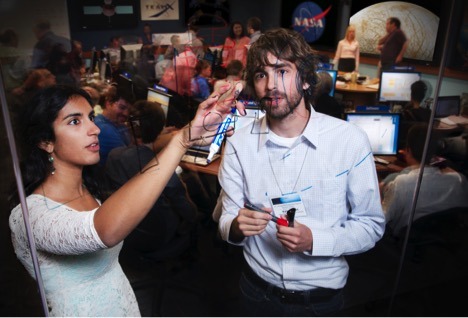
If you’re a U.S. citizen who has graduated from an accredited college or university within the past 2 years (or 6 if you have served in the military), then the our Recent Graduates program is just for you. Accepted applicants are placed in a 1 year career development program with the possibility of an additional year, or even granted term or permanent jobs within the agency. Learn more at: http://nasajobs.nasa.gov/studentopps/employment/rgp.htm.
If you’re a professional…

You can search for our job openings any time at USAJobs.com. Create an account, then use the USAJobs resume builder. Want to make sure your resume maximizes your opportunity for a job at NASA? Check out our Applicant Guide: https://applyonline.nasa.gov/applicant_guide.html.
You can then search for our job openings here: https://nasai.usajobs.gov/.
If you want to be an astronaut…

Astronaut candidate applications are accepted every few years- including right now! Get yours in before the current application closes on February 18, 2016.
Do you have a bachelor’s degree in a STEM field and 3 years of related professional experience? You might be eligible. Find out more and apply online at: https://nasai.usajobs.gov/GetJob/ViewDetails/423817000.
Make sure to follow us on Tumblr for your regular dose of space: http://nasa.tumblr.com
What’s Up for December?

View Mars right now, and prepare for 2016, the best Mars viewing year since 2005! Last month early risers watched small, reddish Mars dance with brighter Jupiter and Venus just before sunrise.

This month Mars rises earlier-by about 2 a.m. local time. Its reddish color is unmistakable, even without a telescope. It's easy to see below the Moon and Jupiter on December 4. You won't see many features this month, because the planet is almost 10 times smaller than nearby Jupiter appears and 350 times smaller than the Moon appears to us on Earth.

You should also be able to see Mars' north polar region this month, because it's currently tilted towards Earth.

You'll be amazed at the changes you'll see during 2016. January through December are all prime Mars observing months. Between January and May next year, Mars triples in apparent diameter as its orbit around the sun brings it closer to Earth. You'll even be able to see the areas on Mars where NASA's Mars landers are located.

By October, Mars shrinks in apparent size to less than half its May diameter as it speeds away from Earth. Mars shrinks even further from October through December, returning to the same size we saw in January 2016 by year's end.
So put Mars viewing on your calendar for 2016. You won't see Mars this size again until 2018, when Mars will put on an even better show.

Make sure to follow us on Tumblr for your regular dose of space: http://nasa.tumblr.com
International Space Station
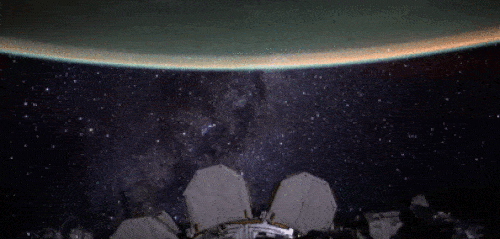
The International Space Station is an important and special place that is built on international cooperation and partnership. The station is a convergence of science, technology and human innovation that benefits and advances our global community here on Earth.

While the space station is an important aspect of our low-Earth orbit exploration, it is also the key to our next giant leap to deep space and our Journey to Mars. For example, our recent VEGGIE experiment aboard the space station is a critical aspect of long-duration exploration missions farther into the solar system. Food grown in space will be a resource for crew members that can provide them will essential vitamins and nutrients that will help enable deep space pioneering.
Another important experiment underway is the Twins Study that involves twin astronauts Scott and Mark Kelly. These investigations will provide insight into the subtle effects and changes that may occur in spaceflight as compared to Earth by studying two individuals who have the same genetics, but are in different environments for one year. You can follow Scott Kelly as he spends a year in space.
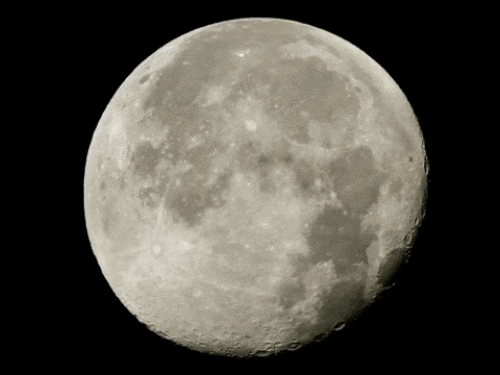
The space station is the second brightest object in the sky (after the moon, of course), and you don’t even need a telescope to see it! We can even tell you exactly when and where to look up to Spot the Station in your area!
So, as you look to spot the station in the sky, remember that even though it may look small from Earth, the crew onboard (and at home) are making contributions to international partnerships and global research.
What’s Up for September?

Stargazing and looking up into the night sky is always a fun thing to do. This month, it will be especially exciting because there will be a total eclipse of a supermoon, plus the opportunity to see planets and the late-summer Milky Way!
What is a supermoon?

A supermoon is a new or full moon that occurs when it is at, or near its closest approach to Earth in a given orbit. There are usually 4 to 6 supermoons every year.
Observers can view the total eclipse on September 27, starting at 10:11 p.m. EDT until 11:23 p.m. This event will be visible in North and South America, as well as Europe and Africa. So make sure to mark your calendars!

This month, you will also be able to see the planets! Look for Mercury, Saturn, Pluto and Neptune in the evening sky. Uranus and Neptune at midnight, and Venus, Mars and Jupiter in the pre-dawn sky.

Finally, if you’re able to escape to a dark location, you might be able to see a great view of our Milky Way!
So, make sure to get outside this month and take a look at everything our night sky has to offer.

Make sure to follow us on Tumblr for your regular dose of space: http://nasa.tumblr.com
Vote While You float: An Astronaut Voting Story
With the excitement of getting to the polls on Election Day many people will have a hard time keeping their feet on the ground, but astronauts who vote literally have to strap themselves down so they don’t float away.
Astronauts orbit the Earth at 17,000 miles per hour, but thanks to a bill passed by Texas legislatures in 1997 that put in place technical voting procedure for astronauts – nearly all of whom live in Texas – they also have the ability to vote from space!

Image Kjell Lindgren released on social media of the US flag floating in the Cupola module (11/12/2015)
For astronauts, the voting process starts a year before launch, when astronauts are able to select which elections (local/state/federal) that they want to participate in while in space. Then, six months before the election, astronauts are provided with a standard form: the “Voter Registration and Absentee Ballot Request – Federal Post Card Application.”
‘Space voting’ was first used the same year it was implemented in 1997. NASA astronaut David Wolf became the first American to vote in space while on the Russian Mir Space Station.

STS-86 crewmember David Wolf, the first American to vote in space, relaxes in the Spacehab module while Space Shuttle Atlantis was docked to Mir (10/16/1997)
While astronauts don’t have to wait in line for his ballot like the rest of us, there is one disadvantage to voting in space: they miss out on the highly coveted “I Voted” sticker.
Make sure to follow us on Tumblr for your regular dose of space: http://nasa.tumblr.com
Mathematician. Leader. Heroine. Remembering Hidden Figure Katherine Johnson
Tonight, count the stars and remember a trailblazer.

We're saddened by the passing of celebrated #HiddenFigures mathematician Katherine Johnson. She passed away at 101 years old.

An America hero, Johnson's legacy of excellence broke down racial and social barriers while helping get our space agency off the ground.

Once a "human computer", she famously calculated the flight trajectory for Alan Shepard, the first American in space.

And when we began to use electronic computers for calculations, astronaut John Glenn said that he’d trust the computers only after Johnson personally checked the math.

As a girl, Katherine Johnson counted everything. As a mathematician, her calculations proved critical to our early successes in space travel.

With slide rules and pencils, Katherine Johnson’s brilliant mind helped launch our nation into space. No longer a Hidden Figure, her bravery and commitment to excellence leaves an eternal legacy for us all.
"We will always have STEM with us. Some things will drop out of the public eye and will go away, but there will always be science, engineering and technology. And there will always, always be mathematics." - Katherine Johnson 1918 -2020
May she rest in peace, and may her powerful legacy inspire generations to come! What does Katherine Johnson’s legacy mean to you? Share in the comments.
Make sure to follow us on Tumblr for your regular dose of space: http://nasa.tumblr.com
It’s a U.S. Record! Cumulative Days in Space: 383

Today, Astronaut Scott Kelly has broken the record for longest time spent in space by a U.S. astronaut! Over the course of his four missions, Kelly has spent 383 cumulative days in space. This record was previously held by Astronaut Mike Fincke, with 382 days in space over three flights. Here are some more fun facts about this milestone:
4: The number of humans that have spent a year or more in orbit on a single mission
215 Days: The record currently held by Mike Lopez-Alegria for most time on a single spaceflight by U.S. astronaut. On Oct. 29, Kelly will break this record
377 Days: The current record for most days in space by a U.S. female astronaut, held by Peggy Whitson
879 Days: The record for most cumulative days in space by a human, currently held by Russian cosmonaut Gennady Padalka

Why Spend a Year in Space?
Kelly’s One-Year Mission is an important stepping stone on our journey to Mars and other deep space destinations. These investigations are expected to yield beneficial knowledge on the medical, psychological and biomedical challenges faced by astronauts during long-duration spaceflight.
Kelly is also involved in the Twins Study, which consists of ten separate investigations that are being conducted with his twin brother, who is on Earth. Since we are able to study two individuals who have the same genetics, but are in different environments for one year, we can gain a broader insight into the subtle effects and changes that may occur in spaceflight.
For regular updates on Kelly’s one-year mission aboard the space station, follow him on social media: Facebook, Twitter, Instagram.
Make sure to follow us on Tumblr for your regular dose of space: http://nasa.tumblr.com

The James Webb Space Telescope has just completed a successful first year of science. Let’s celebrate by seeing the birth of Sun-like stars in this brand-new image from the Webb telescope!
This is a small star-forming region in the Rho Ophiuchi cloud complex. At 390 light-years away, it's the closest star-forming region to Earth. There are around 50 young stars here, all of them similar in mass to the Sun, or smaller. The darkest areas are the densest, where thick dust cocoons still-forming protostars. Huge red bipolar jets of molecular hydrogen dominate the image, appearing horizontally across the upper third and vertically on the right. These occur when a star first bursts through its natal envelope of cosmic dust, shooting out a pair of opposing jets into space like a newborn first stretching her arms out into the world. In contrast, the star S1 has carved out a glowing cave of dust in the lower half of the image. It is the only star in the image that is significantly more massive than the Sun.
Thanks to Webb’s sensitive instruments, we get to witness moments like this at the beginning of a star’s life. One year in, Webb’s science mission is only just getting started. The second year of observations has already been selected, with plans to build on an exciting first year that exceeded expectations. Here’s to many more years of scientific discovery with Webb.
Make sure to follow us on Tumblr for your regular dose of space!
Credits: NASA, ESA, CSA, STScI, Klaus Pontoppidan (STScI)
Solar System: Things to Know This Week
The solar system is vast, and exploring it requires not one expedition, but many. From the sun to the Earth to the depths of space beyond Pluto, an entire fleet of spacecraft is pushing back the frontiers of knowledge. Scientists and engineers around the world work together on dozens of missions, and the results of their work unfold on a daily basis. During any given week, astronauts and robotic spacecraft return thousands of pictures and other data from Earth orbit and from half a dozen other worlds.
The result? It’s nothing short of a visual and intellectual feast. For example, all of the following images were obtained over the course of one week during January this year.
The same missions that took these pictures are still at work – they may be photographing Saturn or transmitting a report from Mars as you read this.
1. The Sun

From its clear vantage point in Earth orbit, our Solar Dynamics Observatory (SDO) observes our nearby star almost continuously. This image shows activity on the sun’s surface on Jan. 18. You can also get similar pictures from SDO daily!
2. The Earth from Afar

The DSCOVR satellite orbits the Earth at a distance of nearly a million miles (1.5 million kilometers). It’s Earth Polychromatic Imaging Camera (EPIC) keeps a steady watch on the home planet. This is how the world turned on Jan. 20. Get the latest daily images from EPIC HERE.
3. Mars from Above

The team that manages the Mars Reconnaissance Orbiter (MRO) recently celebrated a decade of observing the Red Planet. MRO took this detailed look at dunes and rocky buttes in Danielson Crater on Jan. 24. It was 3:06 p.m., local Mars time. On the right stide of the image, dust devils have left tracks in the sand.
4. Comet 67/P

The European Space Agency’s Rosetta probe caught this look at the surface of Comet 67/P from a distance of just 46 miles (75 kilometers) on Jan. 23.
5. Saturn

On the same day (Jan. 23), our Cassini spacecraft continued its odyssey of nearly two decades in space, bringing us this look at the sixth planet. See the latest images from Cassini HERE.
Want to learn more? Read our full list of the 10 things to know this week about the solar system HERE.
Make sure to follow us on Tumblr for your regular dose of space: http://nasa.tumblr.com
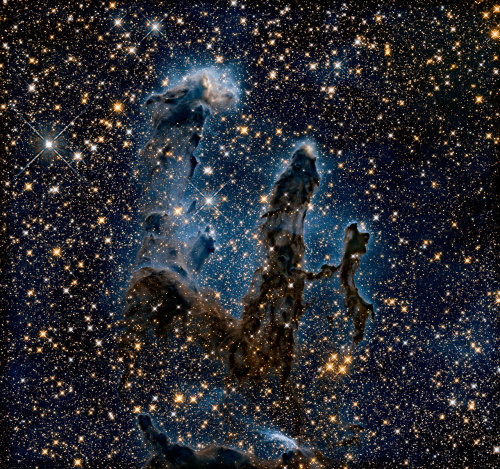
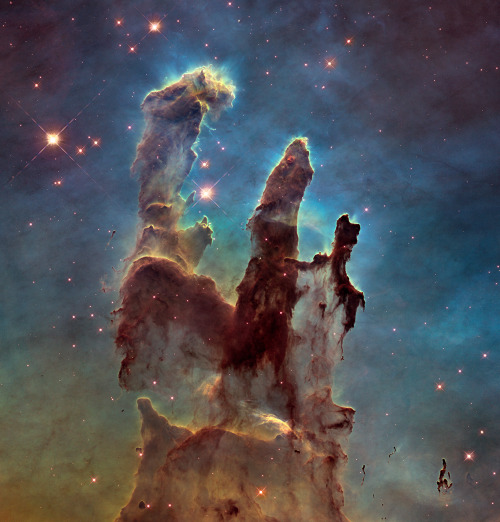
Sometimes... there’s more than meets the eye. 👀 You’re looking at two very different takes on an iconic image.
Human eyes can see only a small portion of the range of radiation given off by the objects around us. We call this wide array of radiation the electromagnetic spectrum, and the part we can see visible light.
In the first image, researchers revisited one of Hubble Space Telescope’s most popular sights: the Eagle Nebula’s Pillars of Creation. Here, the pillars are seen in infrared light, which pierces through obscuring dust and gas and unveil a more unfamiliar — but just as amazing — view of the pillars. The entire frame is peppered with bright stars and baby stars are revealed being formed within the pillars themselves. The image on the bottom is the pillars in visible light.
Image Credit: NASA, ESA/Hubble and the Hubble Heritage Team
Make sure to follow us on Tumblr for your regular dose of space: http://nasa.tumblr.com.
-
 linyarguilera reblogged this · 1 year ago
linyarguilera reblogged this · 1 year ago -
 linyarguilera liked this · 1 year ago
linyarguilera liked this · 1 year ago -
 steffsfuzzball liked this · 6 years ago
steffsfuzzball liked this · 6 years ago -
 spacetimewithstuartgary reblogged this · 6 years ago
spacetimewithstuartgary reblogged this · 6 years ago -
 prettygoodmamgu liked this · 6 years ago
prettygoodmamgu liked this · 6 years ago -
 stillweatcher liked this · 6 years ago
stillweatcher liked this · 6 years ago -
 eswat2 liked this · 6 years ago
eswat2 liked this · 6 years ago -
 sputnikscock420 liked this · 6 years ago
sputnikscock420 liked this · 6 years ago -
 pipuisci reblogged this · 6 years ago
pipuisci reblogged this · 6 years ago -
 pipius liked this · 6 years ago
pipius liked this · 6 years ago -
 andromeda1023 reblogged this · 6 years ago
andromeda1023 reblogged this · 6 years ago -
 andromeda1023 liked this · 6 years ago
andromeda1023 liked this · 6 years ago -
 just99-me06-perhaps reblogged this · 8 years ago
just99-me06-perhaps reblogged this · 8 years ago -
 my1galaxy reblogged this · 8 years ago
my1galaxy reblogged this · 8 years ago -
 my1galaxy liked this · 8 years ago
my1galaxy liked this · 8 years ago -
 cosmicsubs reblogged this · 8 years ago
cosmicsubs reblogged this · 8 years ago -
 spacewomanintheearth reblogged this · 8 years ago
spacewomanintheearth reblogged this · 8 years ago -
 aquaquaa reblogged this · 8 years ago
aquaquaa reblogged this · 8 years ago -
 yozoshimada liked this · 8 years ago
yozoshimada liked this · 8 years ago -
 aurora1010 liked this · 8 years ago
aurora1010 liked this · 8 years ago -
 aurora1010 reblogged this · 8 years ago
aurora1010 reblogged this · 8 years ago -
 brieflyinstantruins liked this · 8 years ago
brieflyinstantruins liked this · 8 years ago -
 mizzsweet1 reblogged this · 8 years ago
mizzsweet1 reblogged this · 8 years ago -
 teresaintheworld liked this · 8 years ago
teresaintheworld liked this · 8 years ago -
 poetcc-things liked this · 8 years ago
poetcc-things liked this · 8 years ago -
 we-will-all-evolve liked this · 8 years ago
we-will-all-evolve liked this · 8 years ago -
 teofilattodeileonzi reblogged this · 8 years ago
teofilattodeileonzi reblogged this · 8 years ago
Explore the universe and discover our home planet with the official NASA Tumblr account
1K posts